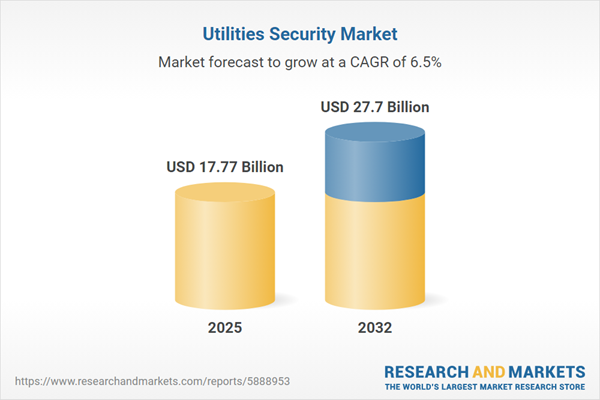Speak directly to the analyst to clarify any post sales queries you may have.
Senior leaders in the utilities sector face rising security challenges driven by digital transformation, regulatory changes, and an increasingly complex threat landscape. The utilities security market demands focused, resilient strategies to safeguard critical assets and support stable operations across electric, gas, and water systems.
Utilities Security Market Snapshot
The utilities security market is projected to reach USD 27.70 billion by 2032, advancing from USD 16.68 billion in 2024 with a compound annual growth rate (CAGR) of 6.54%. Market momentum is fueled by increased investment in smart grid technologies and wider adoption of IoT devices, both of which drive greater connectivity and new vulnerabilities. As utility organizations pursue modernization, they encounter mounting pressure to secure infrastructure against both digital and physical risks, adhere to emerging regulations, and adapt operational strategies in the face of evolving threats. Ensuring operational resilience and compliance are now critical pillars of market growth.
Scope & Segmentation: Utilities Security Market
This report analyzes how technological advancements and regulatory oversight shape the security landscape for utilities globally. Strategic segmentation within the market reflects the nuanced requirements faced by diverse utility providers. Each category allows decision-makers to tailor protection plans and allocate resources to distinct risk profiles, technology stacks, and compliance mandates:
- Component: Advanced security hardware including next-generation firewalls and intelligent monitoring, dedicated security software for automated threat detection and incident management, and services like consulting and managed defense solutions.
- Solution Type: Technology-driven safeguards such as application protection, endpoint security, robust identity management, network security platforms, and end-to-end encryption, each customized to shield operational and informational assets.
- Deployment Mode: Deployment options span cloud-based platforms, on-premises infrastructure for sensitive operations, and hybrid models designed to balance speed, compliance, and integration needs.
- Organization Size: Security needs range from smaller municipal providers with unique regulatory environments to large-scale global utilities facing complex operational and technical challenges.
- Utility Type: Solutions are tailored for electric, gas, and water utilities, each with sector-specific threat vectors and compliance frameworks requiring purpose-built security measures.
- Region: Approaches differ across North America, South America, Europe, Middle East and Africa, and Asia-Pacific, as local regulations and risk factors continue to drive differentiated adoption and security strategies.
Key Companies Profiled
- Cisco Systems, Inc.
- Fortinet, Inc.
- Palo Alto Networks, Inc.
- IBM Corporation
- Check Point Software Technologies Ltd.
- Siemens AG
- ABB Ltd.
- Honeywell International Inc.
- Schneider Electric SE
- Tenable, Inc.
Key Takeaways for Senior Decision-Makers
- Integrated security approaches that combine operational and information technology improve threat visibility and foster cohesive, organization-wide protections.
- Continuous monitoring and adapting to emerging security standards enable utilities to meet evolving compliance mandates and address sophisticated threats in real time.
- Scalable deployment models ensure organizations can meet regional requirements and business objectives, while supporting long-term growth and regulatory compliance.
- Data-driven analytics within security operations improve supply chain monitoring and allow rapid detection and mitigation of vulnerabilities throughout the asset lifecycle.
- Modular security architectures provide pathway-level upgrades, minimize operational disruption, and facilitate ongoing resilience as risks and regulations evolve.
Tariff Impact: Strategic Considerations
Ongoing shifts in U.S. tariffs require utilities to strengthen supplier networks and prioritize local and regional partnerships. By adopting adaptive security technologies and refining sourcing strategies, utilities enhance resilience and maintain operational continuity against supply chain disruptions and shifting market conditions.
Methodology & Data Sources
Findings draw from in-depth executive interviews, up-to-date regulatory reviews, strategic evaluation of major security vendors, and current threat intelligence. Real-world case studies provide additional context, demonstrating how tested security practices reduce risk and support stability across the utilities sector.
Why This Report Matters: Utilities Security Market
- Empowers senior leaders to develop secure, compliant infrastructures that protect ongoing delivery of critical electric, gas, and water services.
- Drives collaboration between IT, operational, and compliance teams for more effective risk reduction and coordinated responses to complex threats.
- Supports informed procurement and long-term investment planning by aligning security solutions with regulatory and operational demands.
Conclusion
This report equips senior decision-makers in utilities with practical insights to drive robust security investments and maintain operational resilience as digital transformation and regulatory requirements continue to evolve.
Additional Product Information:
- Purchase of this report includes 1 year online access with quarterly updates.
- This report can be updated on request. Please contact our Customer Experience team using the Ask a Question widget on our website.
Table of Contents
3. Executive Summary
4. Market Overview
7. Cumulative Impact of Artificial Intelligence 2025
Companies Mentioned
The companies profiled in this Utilities Security market report include:- Cisco Systems, Inc.
- Fortinet, Inc.
- Palo Alto Networks, Inc.
- IBM Corporation
- Check Point Software Technologies Ltd.
- Siemens AG
- ABB Ltd.
- Honeywell International Inc.
- Schneider Electric SE
- Tenable, Inc.
Table Information
| Report Attribute | Details |
|---|---|
| No. of Pages | 191 |
| Published | November 2025 |
| Forecast Period | 2025 - 2032 |
| Estimated Market Value ( USD | $ 17.77 Billion |
| Forecasted Market Value ( USD | $ 27.7 Billion |
| Compound Annual Growth Rate | 6.5% |
| Regions Covered | Global |
| No. of Companies Mentioned | 11 |









